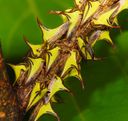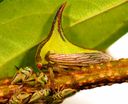Hoplophorionini
Hoplophorionini
Classification
- Phylum: Arthropoda
- Subphylum: Hexapoda
- Class: Insecta
- Order: Hemiptera
- Suborder: Auchenorrhyncha
- Infraorder: Cicadomorpha
- Superfamily: Membracoidea
- Family: Membracidae
- Subfamily: Membracinae
- Tribe: Hoplophorionini
Pronunciation
How to pronounce Hoplophorionini: /hɒpləfɔːrɪˈoʊnɪnaɪ/
These audio files are automatically generated. While they are not always 100% accurate, they are a good starting point.
Images






Summary
Hoplophorionini is a tribe within the family Membracidae, encompassing five species in two genera in our area. Platycotis vittata is a key representative species, specializing in oak trees and exhibiting parental care.
Physical Characteristics
Platycotis vittata, known as the oak treehopper, displays a distinct body shape that is common to treehoppers. It is characterized by its green to brown coloration which aids in camouflage against oak bark.
Identification Tips
Look for the distinctive shape and coloration of the oak treehopper, usually found on oak trees. Adults can be identified through their protective behavior towards nymphs.
Habitat
Primarily found in oak forests and areas where oak trees are present, as it is an oak specialist.
Distribution
Ranges from Canada to Chile, predominant in North America.
Diet
Feeds on the sap of oak trees using its specialized mouthparts to pierce plant tissues.
Life Cycle
Undergoes incomplete metamorphosis, with egg, nymph, and adult stages; nymphs remain with adults for care and protection.
Reproduction
Parental care is exhibited as adults protect their nymphs from predators and environmental stresses.
Ecosystem Role
As a sap-feeding insect, it plays a role in the energy transfer within its ecosystem and serves as a food source for various predators.
Collecting Methods
- Netting adults off oak trees
- Collecting nymphs with plant samples
Preservation Methods
- Pinning adults
- Preserving nymphs in ethanol
Misconceptions
Some may confuse treehoppers with more harmful insects due to their protective posture, but they are primarily harmless.
Tags
- Hoplophorionini
- treehopper
- Platycotis vittata
- oak specialist
- Membracidae